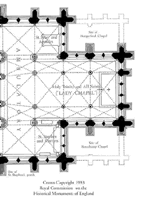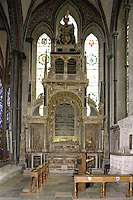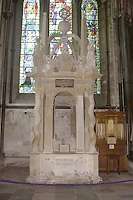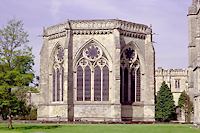Students may investigate the following topics in a simple way or in depth depending upon your requirements. Questions are posed and readings suggested. Encourage students to ask their own questions and to look for additional source material in footnotes and bibliography.
Each topic may be illustrated with images from the archive of the Salisbury Project. Any small or enlarged archival image may be printed. Instructions on the use of Powerpoint for computer-based presentations are also provided.
I. The Trinity Chapel

- 1. Why is Trinity Chapel also called the Lady Chapel?
- 2. What is the Lady Mass or Mass of the Virgin (Missa de Domina)?
- 3. What is the history of these special devotions to the Virgin Mary?
- 4. What are some examples of other Lady Chapels in English churches?
Begin with the article by M.F. Hearn and Lee Willis, "The iconography of the Lady Chapel of Salisbury Cathedral," inMedieval Art and Architecture at Salisbury Cathedral, The British Archaeological Association Conference Transactions XVII, eds. Laurence Keen and Thomas Cocke, Leeds, 1996, pp. 40-45, and use the references to find additional information.
The Catholic Encyclopedia is a good beginning source for information on the liturgy and the Lady Mass.
b. Compare the architectural form of Trinity Chapel to Lady Chapels in other English cathedrals and abbey churches.
- 1. Trace the history of the development of the Lady Chapel in England.
- 2. Trinity Chapel is described as a hall church. Define this term and explain how it applies to Salisbury.
- 3. Compare Trinity Chapel in Salisbury Cathedral to the plan of the cathedral at Old Sarum.
Bibliography:
The article by Hearn and Willis mentioned above gives a list of buildings with Lady Chapels. In the same publication, Medieval Art and Architecture at Salisbury Cathedral is an article by Peter Draper, "Salisbury Cathedral: Paradigm or Maverick?", that discusses the Trinity Chapel, pp. 22-23; refer to Draper's notes for additional sources of information. For a discussion of Old Sarum and Trinity Chapel see Thomas Cocke and Peter Kidson,Salisbury Cathedral Perspectives on the Architectural History, 1993, 74-75; refer to the bibliography on pp. 96098 for additional sources of information.
II. The Hertford Monument

b. What was the connection between the Seymour family and Salisbury Cathedral?
c. Explain the iconography (subject matter) of the imagery on the tomb.
d. Compare this tomb with other 17th-century English tombs.
Bibliography:
Sarah Brown, Sumptuous and Richly Adorn'd: the Decoration of Salisbury Cathedral, London, 1999, 129, and references to other studies, especially articles in the publication Church Monuments. Roy Spring Salisbury Cathedral, The New Bell's Cathedral Guides, London, 1987, 125-127.
The Dictionary of National Biography, now much out of date, is still a good reference for English notables.
III. The Gorges Monument

b. What was the connection between the Gorges family and Salisbury Cathedral?
c. Explain the iconography (subject matter) of the imagery on the tomb.
d. Compare this tomb with other 17th-century English tombs.
Bibliography:
Two articles, Canon J.M. Fletcher, "The Gorges Monument in Salisbury Cathedral," Wiltshire Archaeological and Natural History Magazine, 46 (1932): 16-34 and K.A. Esdaile, "The Gorges Monument in Salisbury Cathedral," Wiltshire Archaeological and Natural History Magazine, 50 (1942-44): 53-62, provide lots of information. See also Roy SpringSalisbury Cathedral, The New Bell's Cathedral Guides, London, 1987, 128-130.
The Dictionary of National Biography, now much out of date, is still a good reference for English notables.
IV. The Chapter House

b. Why did English cathedrals have chapter houses?
c. What kinds of activities took place in chapter houses?
Bibliography:
The Catholic Encyclopedia provides much general information on monasteries and cathedrals.
Kathleen Edwards, The English Secular Cathedrals in the Middle Ages, 2nd ed., Manchester and New York, 1967.
Bibliography:W. S. Gardner, The role of central planning in English Romanesque chapter house design, PhD diss, Princeton Univ., 1976. John R. Zukowsky, The polygonal Chapter House: Architecture and Society in Gothic Britain, PhD. diss, State University of New York at Binghamton, 1977.
e. The iconography of the Old Testament sculpture in the Salisbury
chapter house.
Bibliography:Pamela Z. Blum, The Salisbury Chapter-House and its Old Testament Cycle: An Archaeological and Iconographical Study, PhD diss, Yale University, 1978. See also Pamela Z. Blum, "The Middle English Romance 'Iacob and Iosep' and the Joseph Cycle of the Salisbury Chapter House," Gesta, 8 (1969): 18-34.
